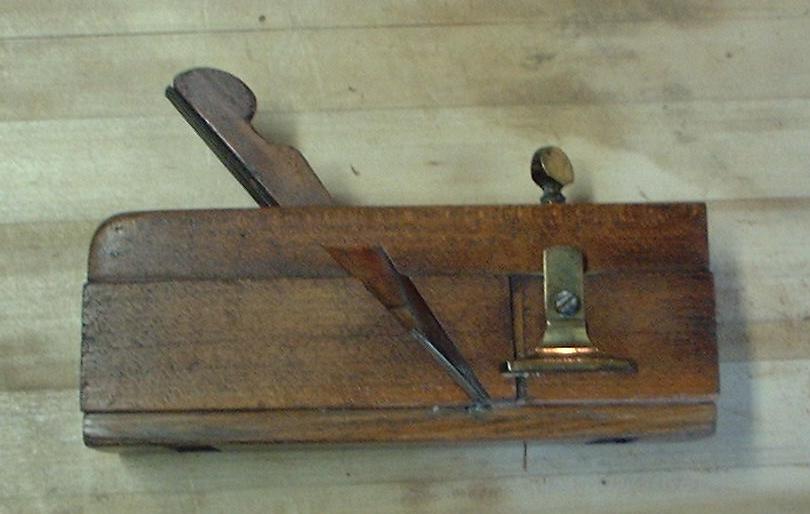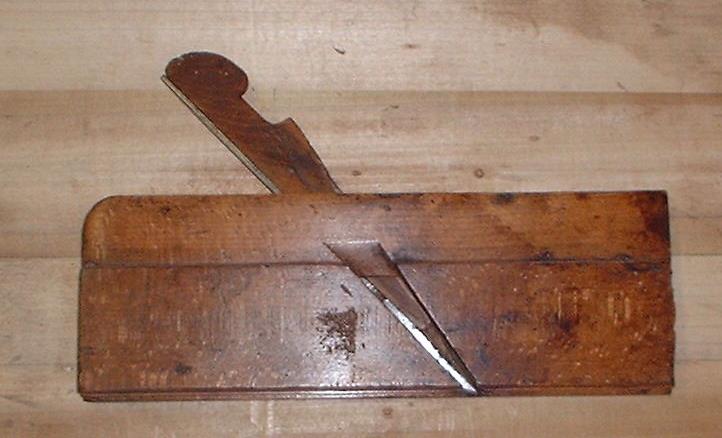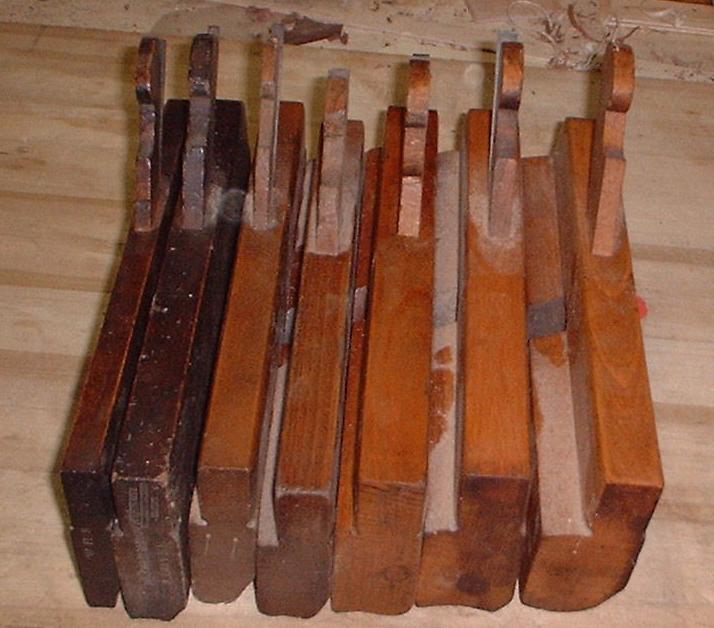

An astragal plane from the H. L. James factory and the profile it cuts
This article with somewhat different illustrations was originally published in Fine Tool Journal. My thanks to Clarence Blanchard for his support.
The Plane Making Career of Henry L. James
by Kenneth F. Greenberg
On the night of December 18, 1869, a fire broke out in the plane making factory of Henry L. James in Williamsburg, Massachusetts. The newspaper account from the Northampton Courier newspaper, reprinted in A History of the Williamsburg Fire Department [1], gives the following account.
The plane and moulding tool manufactory of H. L. James, situated in the center of this village, was totally destroyed by fire on Saturday morning, December 18. The fire was first discovered a little past three o’clock and the alarm promptly given. But the fire was under such headway that it was impossible to save any thing except an engine lathe and a few tools from the basement of the building… The total loss for the fire is variously estimated at from $7,000 to $10,000. The building and water wheel were the property f John Woodard, upon which he had an insurance of $800. Mr. James, who sustained the majority of the loss, was without any insurance, as were his men employed, who lost good sets of tools, probably to the amount of $1,200, and as it in some cases was their little all, outside their households, their loss direct and by being thrown out of employment, is felt as much by those whose loss figures up higher. Caught probably from stoves.
This was the end of Henry James as a plane manufacturer, although he was able to save the finished goods inventory. It was kept in a store owned by Gross Williams only 25 or 30 feet from the burning building; Only the "timely use of water and the fact of there being a very slight breeze in the right direction when the fire was the hottest" allowed it to be saved. No attempt at rebuilding was ever made.
We have better accounts of the end of Henry James’s career in the tool business than of the beginning or of the time in which his factory was in operation. This can perhaps be attributed to the spectacular demise of the enterprise, rendering it more newsworthy than everyday events during the time period in which a good number of tools emerged from the factory. But Henry L. James was a man of many interests, and is not thought of locally as a plane maker but rather as a wool merchant. Today, we would simply call him an entrepreneur. There is no record of his ever had any training or apprenticeship in the tool business, and we can probably safely assume that he was simply a businessman who gave tool making a try for a number of years, along with several other interests.
In November of 2002 I went back to Williamsburg in search of more information, as I own a number of wooden molding planes produced in the H. L. James factory. As I acquired more of his tools, I developed an urge to find out more about his career. The fact that my Mother lives about half an hour away from the town in which my planes were made allowed me to take a day off during a visit and head for the Williamsburg area to do a little research into local records. I was a bit disappointed to learn that the Meekins library in Williamsburg was under renovation and closed, but a number of important references had been moved to the tiny Haydenville branch library. The staff of the library was extremely helpful, and introduced me to Mr. Ralmon Black, head of the local historical society and a relative of H. L. James himself. All these people provided pointers into the local history reference materials that allowed me to accomplish a great deal in the short time I had available. As it turns out, the Meekins library (built in 1896) is the site of the H. L. James plane factory, and I walked the area as best I could under the circumstances. I also visited the Forbes library in Northampton, which has the complete contents of the Courier on microfilm – and yet another reference librarian with an interest in local history who knew exactly where to look. Thus, I was able to collect most of the information I needed – although like most research, new questions arise about as fast as answers.
Henry James was born in Williamsburg on February 13, 1829 to Enoch and Armanilla James. His father was a long-time merchant in the town, and Henry’s first experience in the work force was in his father’s store. When his father moved to Ann Arbor, Michigan, Henry took over the mercantile business. He also took over a woolen mill, starting a second career that he would follow several times during his life. Eventually he took his brother, L. D. James, as a partner in the mercantile business and seems to have delegated much of running the store to him. In 1854 [2], he acquired the plane making business of Henry S. Wells and managed it until the fire destroyed it. Thus, we know that he entered the tool business through acquisition, rather than through an apprenticeship as a tool maker. One report in the Courier suggests that the acquisition was around the same time as his brother took over the operations of the mercantile (circa 1866), but this is in conflict with the industrial census records. It must have been earlier than the 1860 record where he was already listed as a plane maker.
Henry S. Wells, who worked in Northampton, Massachusetts as well as in Williamsburg (the towns are only eight miles apart) had a more conventional tool background. He was an apprentice to the well-known plane maker Hermon Chapin before starting his own company. Thus, we can assume that the men in the factory were trained by Henry Wells, and it may even be safe to assume that Wells ran the plane making side of the operation for at least a number of years while Henry James was the businessman. This is somewhat borne out by the existence of planes with both a Henry Wells stamp and a James Manufacturing Company stamp. However, the dates during which Wells worked in Williamsburg are not really well known at this point. We also do not know exactly when the "H. L. James" stamps were in use, as compared to the James Manufacturing Co. stamp.
Phyllis Baker Deming’s book A History of Williamsburg in Massachusetts [3] provides some additional information about the factory in operation, although information is sketchy. We do know that at its peak, between twelve and twenty men were employed in plane making at the H. L. James factory.
Research by others in Guide to the Makers of American Wooden Planes [4] notes that the 1860 Massachusetts industrial census lists H. L. James as a tool manufacturer. He employed eleven "hands" and produced 5000 planes, probably just the production for that year as his planes are frequently found. It is noted that he was also listed as a manufacturer in 1870, but we now know that this was his second wool business and that the tool business ended in the previous year, or perhaps slightly later when the inventory was eventually sold off. A relationship to Henry Wells is noted, but not that James actually acquired the Wells business as other records indicate. The entry for Henry Wells indicates that he was also listed in the 1860 census as employing twelve hands and producing 31,000 planes in Williamsburg. This suggests that both men were working at the same time, although this is somewhat inconsistent with the idea that Henry James acquired the business of Henry Wells. Some additional research on Henry Wells might explain what really happened.

Further complicating the situation is the existence of some fairly rare planes marked only as Eagle Manufacturing Co., Williamsburg, Massachusetts. The location stamp appears identical to the one used on some planes by H.L. James and some by Henry Wells. Note the imprint from an H. L. James moving filletster shown above. The location die reading "Wms.burg" is identical to those seen on some Wells and Eagle planes. Thus, we have four different "makers" (H. L. James, H. Wells, James Manufacturing. Co, and Eagle Manufacturing Co.) all somewhat concurrent and all working in one very small town. The fact that James acquired the Wells business is only part of what Pollak refers to as an "untold story."
The 1865 Massachusetts Industial Census [5] is clear about one point, however. In that year there was only a single entity in the planemaking business in the Town of Williamsburg:
Planes, Moulding Tools, &c., establishments for m. of, 1; gross value m'd, $25,000 ; value of stock used, $18,000 ; cap., $10,000 ; hands emp., 10.
So, whether Henry James and Henry Wells were both associated with it at that point or only the former, we at least know it was the only source of planes made in Williamsburg.
Since James had concurrent interests in other businesses, it is unlikely that he was devoting full time to the plane making business. In addition to his commercial ventures, James was appointed by Abraham Lincoln to be postmaster, a position he held for 25 years. He also served in the Massachusetts legislature for a year, and was a frequent delegate to political conventions and active in the Republican Party.
While observing his many interests, it is also worth noting that disaster did seem to follow all of his business ventures with the exception of the original mercantile operation started by his father. His first woolen mill at West Whately was destroyed by a cyclone, and later the buildings that survived suffered the same fate as his tool factory. He later acquired a woolen mill in Williamsburg, but that was rendered useless in the flood of 1874. While his mill was one of the few in the area to survive the flood, his mill pond silted up and he no longer had power to run it. He lost a good deal of his inventory in the flood, as well as eleven houses associated with the mill.
Henry L. James died in 1896, the same year that the library was built at the former plane factory site. His obituary refers to him as the "sage of Williamsburg" and carries the subtitle "The Woolen Manufacturer Dies at Williamsburg" reflecting what must have been thought of as his primary occupation. The James family is well remembered in town today. Henry’s daughter-in-law, Helen E. James, endowed the High School in Williamsburg that bears her name with a trust fund left her by her brother, Marshall Field of Chicago.
References

An H. L. James moving filletster.

An H. L. James 1/8 inch side bead.

A group of James hollows and rounds in various sizes.